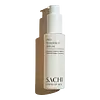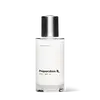What's inside
What's inside
 Key Ingredients
Key Ingredients

 Benefits
Benefits

 Concerns
Concerns

No concerns
 Ingredients Side-by-side
Ingredients Side-by-side

Water
Skin ConditioningGlycerin
HumectantPanthenol
Skin ConditioningPropanediol
SolventPentylene Glycol
Skin ConditioningSodium Carboxymethyl Betaglucan
Polygonum Aviculare Extract
EmollientRosmarinyl Glucoside
AntioxidantCaffeyl Glucoside
AntioxidantGallyl Glucoside
AntioxidantPalmitoyl Hexapeptide-52
Skin ConditioningPalmitoyl Hexapeptide-19
Skin ConditioningSodium Hyaluronate
HumectantTamarindus Indica Seed Extract
EmollientCeramide NP
Skin ConditioningCeramide AP
Skin ConditioningPhytosphingosine
Skin ConditioningCeramide EOP
Skin ConditioningArnica Montana Flower Extract
MaskingCurcuma Longa Root Extract
MaskingSilybum Marianum Seed Extract
Skin ConditioningThymus Vulgaris Leaf Extract
Skin ProtectingAloe Barbadensis Leaf Juice Powder
Skin ConditioningSodium Anisate
AntimicrobialCentella Asiatica Extract
CleansingCitric Acid
BufferingGlycyrrhiza Glabra Root Extract
BleachingCucumis Sativus Fruit Extract
EmollientSodium Lauroyl Lactylate
EmulsifyingSodium Benzoate
MaskingLeuconostoc/Radish Root Ferment Filtrate
AntimicrobialButylene Glycol
HumectantPhenoxyethanol
PreservativeSodium Levulinate
Skin ConditioningXanthan Gum
EmulsifyingPotassium Sorbate
PreservativeAphanothece Sacrum Polysaccharide
AbsorbentCholesterol
EmollientCarbomer
Emulsion StabilisingEthylhexylglycerin
Skin ConditioningPolyvinyl Alcohol
Lactic Acid/Glycolic Acid Copolymer
Skin ConditioningWater, Glycerin, Panthenol, Propanediol, Pentylene Glycol, Sodium Carboxymethyl Betaglucan, Polygonum Aviculare Extract, Rosmarinyl Glucoside, Caffeyl Glucoside, Gallyl Glucoside, Palmitoyl Hexapeptide-52, Palmitoyl Hexapeptide-19, Sodium Hyaluronate, Tamarindus Indica Seed Extract, Ceramide NP, Ceramide AP, Phytosphingosine, Ceramide EOP, Arnica Montana Flower Extract, Curcuma Longa Root Extract, Silybum Marianum Seed Extract, Thymus Vulgaris Leaf Extract, Aloe Barbadensis Leaf Juice Powder, Sodium Anisate, Centella Asiatica Extract, Citric Acid, Glycyrrhiza Glabra Root Extract, Cucumis Sativus Fruit Extract, Sodium Lauroyl Lactylate, Sodium Benzoate, Leuconostoc/Radish Root Ferment Filtrate, Butylene Glycol, Phenoxyethanol, Sodium Levulinate, Xanthan Gum, Potassium Sorbate, Aphanothece Sacrum Polysaccharide, Cholesterol, Carbomer, Ethylhexylglycerin, Polyvinyl Alcohol, Lactic Acid/Glycolic Acid Copolymer
Water
Skin ConditioningPanthenol
Skin ConditioningSqualane
EmollientGlycerin
HumectantPropanediol
SolventSucrose Distearate
EmollientCarthamus Tinctorius Seed Oil
MaskingLactococcus Ferment Lysate
Skin ConditioningGlucosyl Hesperidin
HumectantCarnosine
Skin ConditioningPhytosphingosine
Skin ConditioningCeramide NP
Skin ConditioningCeramide Ns
Skin ConditioningCeramide As
Skin ConditioningCeramide AP
Skin ConditioningCeramide EOP
Skin ConditioningCholesterol
EmollientPentylene Glycol
Skin ConditioningCetearyl Alcohol
EmollientStearic Acid
CleansingPolyquaternium-51
Skin ConditioningHydroxypropyl Methylcellulose
Emulsion StabilisingSodium Chloride
MaskingLithothamnion Calcareum Extract
Skin ConditioningAmylopectin
Sodium Hyaluronate
HumectantArginine
MaskingDextrin
AbsorbentXanthan Gum
EmulsifyingAcrylates/C10-30 Alkyl Acrylate Crosspolymer
Emulsion StabilisingAllantoin
Skin ConditioningDipotassium Glycyrrhizate
HumectantCI 77220
Cosmetic ColorantCitric Acid
BufferingHydrogenated Lecithin
EmulsifyingPotassium Cetyl Phosphate
Emulsifying1,2-Hexanediol
Skin ConditioningHydroxyacetophenone
AntioxidantPotassium Sorbate
PreservativePotassium Benzoate
PreservativePhenylpropanol
MaskingLevulinic Acid
PerfumingSodium Levulinate
Skin ConditioningWater, Panthenol, Squalane, Glycerin, Propanediol, Sucrose Distearate, Carthamus Tinctorius Seed Oil, Lactococcus Ferment Lysate, Glucosyl Hesperidin, Carnosine, Phytosphingosine, Ceramide NP, Ceramide Ns, Ceramide As, Ceramide AP, Ceramide EOP, Cholesterol, Pentylene Glycol, Cetearyl Alcohol, Stearic Acid, Polyquaternium-51, Hydroxypropyl Methylcellulose, Sodium Chloride, Lithothamnion Calcareum Extract, Amylopectin, Sodium Hyaluronate, Arginine, Dextrin, Xanthan Gum, Acrylates/C10-30 Alkyl Acrylate Crosspolymer, Allantoin, Dipotassium Glycyrrhizate, CI 77220, Citric Acid, Hydrogenated Lecithin, Potassium Cetyl Phosphate, 1,2-Hexanediol, Hydroxyacetophenone, Potassium Sorbate, Potassium Benzoate, Phenylpropanol, Levulinic Acid, Sodium Levulinate
 Reviews
Reviews

Ingredients Explained
These ingredients are found in both products.
Ingredients higher up in an ingredient list are typically present in a larger amount.
Ceramide AP is a type of Ceramide.
Ceramides are intercellular lipids naturally found in our skin that bonds dead skin cells together to create a barrier. Having a strong skin barrier leads to more firm and hydrated skin.
They are known for their ability to hold water and thus are a great ingredient for dry skin. By bolstering the skin ceramides act as a barrier against irritating ingredients. This can help with inflammation as well.
If you would like to eat ceramides, sweet potatoes contain a small amount.
Read more about other common types of ceramides here:
Ceramide NP
Ceramide EOP
Ceramide EOP is a type of Ceramide.
EOP stands for a linked Ester fatty acid, a linked Omega hydroxy fatty acid, and the Phytosphingosine base.
Ceramides are intercellular lipids naturally found in our skin. They bind dead skin cells together to create a barrier. The ceramides in our skin have the ability to hold water to keep our skin hydrated.
Ceramides are an important building block for our skin barrier. A strong skin barrier helps with:
If you would like to eat ceramides, sweet potatoes contain a small amount.
Read more about other common types of ceramides here:
Learn more about Ceramide EOPCeramide NP is a type of ceramide.
Ceramides are intercellular lipids naturally found in our skin that bonds dead skin cells together to create a barrier. They are known for their ability to hold water and thus are a great ingredient for dry skin.
Ceramides are an important building block for our skin barrier. A stronger barrier helps the skin look more firm and hydrated. By bolstering the skin ceramides act as a barrier against irritating ingredients. This can help with inflammation as well.
If you would like to eat ceramides, sweet potatoes contain a small amount.
Read more about other common types of ceramides here:
Ceramide AP
Ceramide EOP
Cholesterol is a class of organic molecules called lipids. It helps hydrate your skin and is essential to having a healthy skin barrier.
Our skin naturally contains cholesterol in the outermost layer. Besides cholesterol, it also contains ceramides and fatty acids. Cholesterol makes up about 1/4 of your skin's outer layer and barrier. Your skin barrier is responsible for keeping allergens and microbes out. Having a healthy skin barrier is also responsible for keeping your skin firm and plump.
Our bodies use cholestrol to create vitamin D, steroid hormones, and more.
Learn more about CholesterolCitric Acid is an alpha hydroxy acid (AHA) naturally found in citrus fruits like oranges, lemons, and limes.
Like other AHAs, citric acid can exfoliate skin by breaking down the bonds that hold dead skin cells together. This helps reveal smoother and brighter skin underneath.
However, this exfoliating effect only happens at high concentrations (20%) which can be hard to find in cosmetic products.
Due to this, citric acid is usually included in small amounts as a pH adjuster. This helps keep products slightly more acidic and compatible with skin's natural pH.
In skincare formulas, citric acid can:
While it can provide some skin benefits, research shows lactic acid and glycolic acid are generally more effective and less irritating exfoliants.
Most citric acid used in skincare today is made by fermenting sugars (usually from molasses). This synthetic version is identical to the natural citrus form but easier to stabilize and use in formulations.
Read more about some other popular AHA's here:
Learn more about Citric AcidGlycerin is already naturally found in your skin. It helps moisturize and protect your skin.
A study from 2016 found glycerin to be more effective as a humectant than AHAs and hyaluronic acid.
As a humectant, it helps the skin stay hydrated by pulling moisture to your skin. The low molecular weight of glycerin allows it to pull moisture into the deeper layers of your skin.
Hydrated skin improves your skin barrier; Your skin barrier helps protect against irritants and bacteria.
Glycerin has also been found to have antimicrobial and antiviral properties. Due to these properties, glycerin is often used in wound and burn treatments.
In cosmetics, glycerin is usually derived from plants such as soybean or palm. However, it can also be sourced from animals, such as tallow or animal fat.
This ingredient is organic, colorless, odorless, and non-toxic.
Glycerin is the name for this ingredient in American English. British English uses Glycerol/Glycerine.
Learn more about GlycerinPanthenol is a common ingredient that helps hydrate and soothe the skin. It is found naturally in our skin and hair.
There are two forms of panthenol: D and L.
D-panthenol is also known as dexpanthenol. Most cosmetics use dexpanthenol or a mixture of D and L-panthenol.
Panthenol is famous due to its ability to go deeper into the skin's layers. Using this ingredient has numerous pros (and no cons):
Like hyaluronic acid, panthenol is a humectant. Humectants are able to bind and hold large amounts of water to keep skin hydrated.
This ingredient works well for wound healing. It works by increasing tissue in the wound and helps close open wounds.
Once oxidized, panthenol converts to pantothenic acid. Panthothenic acid is found in all living cells.
This ingredient is also referred to as pro-vitamin B5.
Learn more about PanthenolPentylene glycol is typically used within a product to thicken it. It also adds a smooth, soft, and moisturizing feel to the product. It is naturally found in plants such as sugar beets.
The hydrophilic trait of Pentylene Glycol makes it a humectant. As a humectant, Pentylene Glycol helps draw moisture from the air to your skin. This can help keep your skin hydrated.
This property also makes Pentylene Glycol a great texture enhancer. It can also help thicken or stabilize a product.
Pentylene Glycol also acts as a mild preservative and helps to keep a product microbe-free.
Some people may experience mild eye and skin irritation from Pentylene Glycol. We always recommend speaking with a professional about using this ingredient in your routine.
Pentylene Glycol has a low molecular weight and is part of the 1,2-glycol family.
Learn more about Pentylene GlycolPhytosphingosine is a phospholipid naturally found in our skin as a building block for ceramides.. It helps moisturize, soothe, and protect skin.
Phytosphingosine contributes to your skin's natural moisturizing factor (NMF). The NMF is responsible for hydration, a strong barrier, and plasticity. Our NMF decreases with age. Increasing NMF leads to more healthy and hydrated skin.
Studies show products formulated with NMF ingredients help strengthen our skin's barrier. Having a healthy skin barrier reduces irritation and increases hydration. Our skin barrier is responsible for having plump and firm skin. It also helps protect our skin against infection, allergies, and inflammation.
Fun fact: Phytosphingosine is abundant in plants and fungi.
More ingredients that help boost collagen in skin:
Learn more about PhytosphingosinePotassium Sorbate is a preservative used to prevent yeast and mold in products. It is commonly found in both cosmetic and food products.
This ingredient comes from potassium salt derived from sorbic acid. Sorbic acid is a natural antibiotic and effective against fungus.
Both potassium sorbate and sorbic acid can be found in baked goods, cheeses, dried meats, dried fruit, ice cream, pickles, wine, yogurt, and more.
You'll often find this ingredient used with other preservatives.
Learn more about Potassium SorbatePropanediol is an all-star ingredient. It softens, hydrates, and smooths the skin.
It’s often used to:
Propanediol is not likely to cause sensitivity and considered safe to use. It is derived from corn or petroleum with a clear color and no scent.
Learn more about PropanediolSodium Hyaluronate is hyaluronic acid's salt form. It is commonly derived from the sodium salt of hyaluronic acid.
Like hyaluronic acid, it is great at holding water and acts as a humectant. This makes it a great skin hydrating ingredient.
Sodium Hyaluronate is naturally occurring in our bodies and is mostly found in eye fluid and joints.
These are some other common types of Hyaluronic Acid:
Learn more about Sodium HyaluronateSodium levulinate is the a sodium salt of Levulinic Acid. If dissolved in an aqueous solution, the two ingredients become identical.
It is a skin conditioning agent, meaning it helps soften and hydrate your skin.
According to Cosmetic Ingredient Review, the highest amounts of sodium levulinate are found in mouthwashes at 0.62%.
Learn more about Sodium LevulinateWater. It's the most common cosmetic ingredient of all. You'll usually see it at the top of ingredient lists, meaning that it makes up the largest part of the product.
So why is it so popular? Water most often acts as a solvent - this means that it helps dissolve other ingredients into the formulation.
You'll also recognize water as that liquid we all need to stay alive. If you see this, drink a glass of water. Stay hydrated!
Learn more about WaterXanthan gum is used as a stabilizer and thickener within cosmetic products. It helps give products a sticky, thick feeling - preventing them from being too runny.
On the technical side of things, xanthan gum is a polysaccharide - a combination consisting of multiple sugar molecules bonded together.
Xanthan gum is a pretty common and great ingredient. It is a natural, non-toxic, non-irritating ingredient that is also commonly used in food products.
Learn more about Xanthan Gum